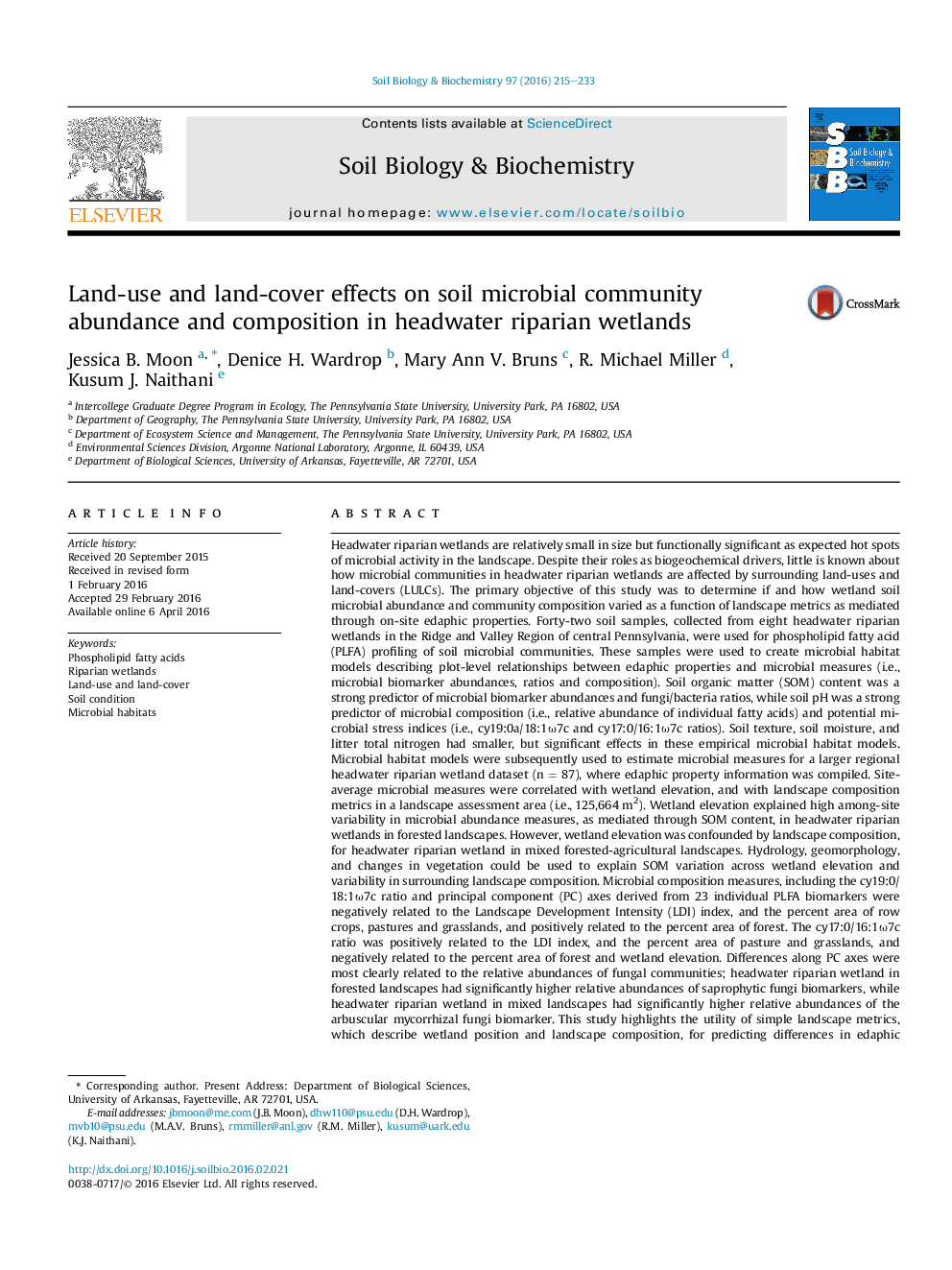| کد مقاله | کد نشریه | سال انتشار | مقاله انگلیسی | نسخه تمام متن |
|---|---|---|---|---|
| 2024336 | 1542587 | 2016 | 19 صفحه PDF | دانلود رایگان |
• PLFA biomarker abundances were strongly related to soil organic matter content.
• Wetland PLFA biomarker abundances varied across elevation in forested landscapes.
• PLFA composition differed between wetlands in forested and mixed landscapes.
• Variation in PLFA composition was attributed to soil pH, texture, and moisture.
• Landscape metrics can be utilized to predict wetland microbial communities.
Headwater riparian wetlands are relatively small in size but functionally significant as expected hot spots of microbial activity in the landscape. Despite their roles as biogeochemical drivers, little is known about how microbial communities in headwater riparian wetlands are affected by surrounding land-uses and land-covers (LULCs). The primary objective of this study was to determine if and how wetland soil microbial abundance and community composition varied as a function of landscape metrics as mediated through on-site edaphic properties. Forty-two soil samples, collected from eight headwater riparian wetlands in the Ridge and Valley Region of central Pennsylvania, were used for phospholipid fatty acid (PLFA) profiling of soil microbial communities. These samples were used to create microbial habitat models describing plot-level relationships between edaphic properties and microbial measures (i.e., microbial biomarker abundances, ratios and composition). Soil organic matter (SOM) content was a strong predictor of microbial biomarker abundances and fungi/bacteria ratios, while soil pH was a strong predictor of microbial composition (i.e., relative abundance of individual fatty acids) and potential microbial stress indices (i.e., cy19:0a/18:1ω7c and cy17:0/16:1ω7c ratios). Soil texture, soil moisture, and litter total nitrogen had smaller, but significant effects in these empirical microbial habitat models. Microbial habitat models were subsequently used to estimate microbial measures for a larger regional headwater riparian wetland dataset (n = 87), where edaphic property information was compiled. Site-average microbial measures were correlated with wetland elevation, and with landscape composition metrics in a landscape assessment area (i.e., 125,664 m2). Wetland elevation explained high among-site variability in microbial abundance measures, as mediated through SOM content, in headwater riparian wetlands in forested landscapes. However, wetland elevation was confounded by landscape composition, for headwater riparian wetland in mixed forested-agricultural landscapes. Hydrology, geomorphology, and changes in vegetation could be used to explain SOM variation across wetland elevation and variability in surrounding landscape composition. Microbial composition measures, including the cy19:0/18:1ω7c ratio and principal component (PC) axes derived from 23 individual PLFA biomarkers were negatively related to the Landscape Development Intensity (LDI) index, and the percent area of row crops, pastures and grasslands, and positively related to the percent area of forest. The cy17:0/16:1ω7c ratio was positively related to the LDI index, and the percent area of pasture and grasslands, and negatively related to the percent area of forest and wetland elevation. Differences along PC axes were most clearly related to the relative abundances of fungal communities; headwater riparian wetland in forested landscapes had significantly higher relative abundances of saprophytic fungi biomarkers, while headwater riparian wetland in mixed landscapes had significantly higher relative abundances of the arbuscular mycorrhizal fungi biomarker. This study highlights the utility of simple landscape metrics, which describe wetland position and landscape composition, for predicting differences in edaphic variability and associated microbial community composition and biomass among headwater riparian wetlands at a regional scale.
Journal: Soil Biology and Biochemistry - Volume 97, June 2016, Pages 215–233
